What Do Network Teams (Really) Care About in 2024?

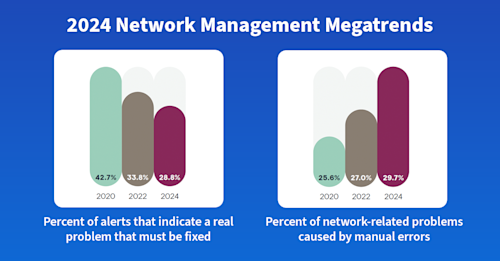
Summary
The 2024 EMA Network Megatrends surveyed hundreds of IT professionals about their approach to managing, monitoring, and troubleshooting their networks. In this post, we examine the report’s findings to learn the business and technology trends shaping network operations strategy.
The world of network management is always changing, full of new gadgets and old problems. The EMA Network Management Megatrends 2024 report sheds light on these trends, helping us understand where we stand and where we might be heading. Here’s a look at the key findings, why they matter, and how Kentik fits into the picture without making it all about us.
See how IT professionals responded to the EMA survey about their approach to managing, monitoring, and troubleshooting their networks.
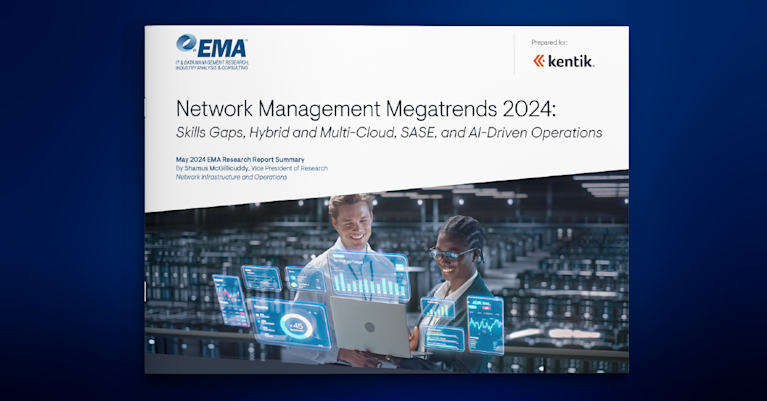
The comeback of network operations
One of the most cheerful findings from the report is that network operations are bouncing back. After years of giving themselves low marks, 42% of network operations groups now say they are fully successful, up from just 27% in 2022. The secret? AI tools, better alignment with cloud, SaaS, and SASE, and more integrated management toolsets.

Picture a large bank struggling with network visibility due to its hybrid cloud infrastructure. By using AI-enhanced observability tools, they could streamline their processes, drastically reducing downtime and improving overall network health. This shows a broader trend where organizations are using advanced tech to boost their network management.
Tackling operational challenges
Despite the good news, network teams still face significant challenges. The report says only 29% of network alerts are actually useful, and manual errors cause nearly 30% of network issues. The sheer volume of alerts can overwhelm even the best teams, leading to missed critical problems and longer troubleshooting times.
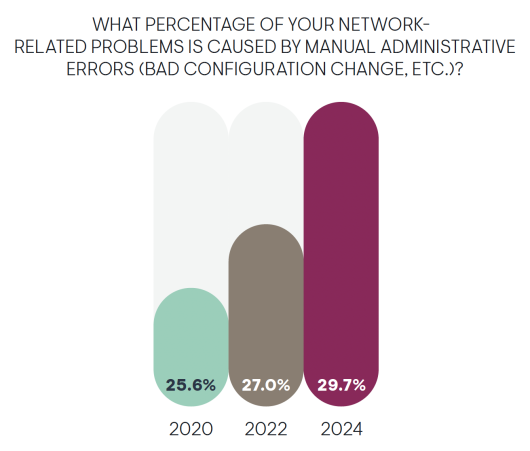
Imagine a global retailer with an extensive online presence. Their network team might get thousands of alerts every day, many of which are false alarms. By refining their alert management processes and adopting AI to filter out the noise, they can focus on real issues, cutting response times and preventing disruptions to their e-commerce platforms. This highlights how important good alert management is.
The skills gap and hiring headaches
Finding skilled network pros is still tough, with 41% of organizations saying it’s hard to hire and keep these people. Skills in network security and automation are particularly tough to find, posing risks to network resilience and security.

Take a midsized company starting a digital transformation. They might struggle to find qualified network security experts. This gap can slow down their ability to secure their growing network, exposing them to potential cyber threats. Filling this skills gap is crucial for protecting digital assets and ensuring smooth network operations.
And it’s not just midsize organizations feeling the labor pinch. We are experiencing a demographic shift that is leaving its mark on network engineering tradecraft, with certain functions of network monitoring becoming lost arts. This is driven by a desire for diverse skill sets, with an increased breadth of expertise being favored over deep artisans of network data exploration. Leading solutions are codifying those artisans’ tradecraft into expert AI-assisted troubleshooting and investigations to make room for the versatilists operating networks by wearing dozens of hats.
Navigating hybrid and multi-cloud environments
With over 56% of network teams supporting multi-cloud environments, strong monitoring and troubleshooting are more critical than ever. The top priorities for these organizations are adopting end-to-end multi-cloud network fabrics and hybrid cloud connectivity.
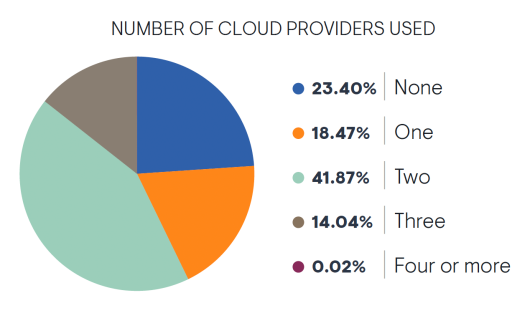
Think of a media company that distributes a vast array of digital content, including news, movies, TV shows, and live sports events. To optimize delivery and ensure high availability, the company uses a multi-cloud strategy, leveraging AWS, Google Cloud, and Azure for different parts of its infrastructure — and remaining hybridized with their own data centers around the globe. How do you make sense of or even draw out a standard of measure with so much diversity?
Despite the benefits, managing this multi-cloud environment introduces significant complexity and operational challenges. Today’s network solutions must advance from observability to inference, enabling more people to tap into the meaning of their clouds and networks regardless of how they shift, evolve, and morph into all new forms.
SASE adoption and its challenges
SASE (secure access service edge) is catching on, with nearly 46% of organizations fully implementing these solutions. But, managing security policies and ensuring visibility into SASE points of presence remains tough.

For a multinational company with remote employees across different regions, implementing SASE can enhance security and connectivity. However, managing multiple security policies and gaining visibility into the network’s performance can be daunting. Integrating observability tools that provide detailed insights into SASE infrastructure can simplify these tasks, ensuring a secure and efficient remote work setup.
As SASE gains traction, SD-WAN monitoring remains paramount because managing multiple security policies and ensuring network visibility poses significant challenges.
SD-WAN is critical because it provides the foundational connectivity layer that SASE builds upon. Effective SD-WAN implementation ensures reliable and optimized paths for data traffic, which is essential for maintaining performance and efficiency in a SASE environment. Monitoring SD-WAN is crucial as it offers real-time insights into network performance, helping identify and resolve issues promptly, thereby ensuring a seamless user experience.
Integrating observability tools that provide detailed insights into both SD-WAN and SASE infrastructures is essential. These tools simplify security policies and enhance visibility across the network by continuously monitoring SD-WAN to ensure the underlying dependency for SASE deployments is secure, efficient, and capable of supporting the demands of a modern, remote workforce. In essence, SD-WAN monitoring is indispensable for optimizing SASE performance and maintaining a robust, secure network infrastructure.
The role of AI/ML in network management
AI and machine learning are becoming mainstream, with 64% of organizations using these features to boost security threat detection, automate problem fixing, and improve network troubleshooting. The impact of AI/ML on network management is huge, offering new levels of efficiency and accuracy.
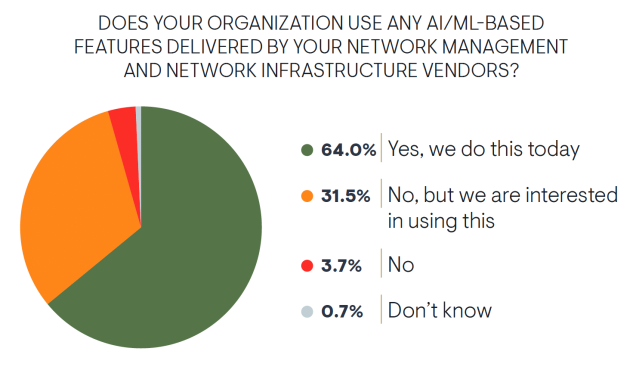
And while it is commonplace to see “back of the house” AI/ML in observability solutions, leading providers are now embedding generative AI into their platforms – like Kentik. Using simple, natural language to prompt a response based on the data and intent of users’ questions.
Through an interactive, conversational interface, the network source of truth becomes accessible and approachable for network and I&O teams pressed for time while wearing multiple hats of responsibility. Getting to the heart of a trouble ticket or failed mesh test is essential. And AI can help network teams move fast to support far-ranging stakeholders and domains across devices, data centers, clouds, containers, apps, and edges.
Kentik’s perspective
Running networks is hard. Running networks in 2024 is really hard. At Kentik, we get the complexities and challenges highlighted in the EMA report. Our mission is to make it easy for network teams with the unified workbench they need to handle these challenges. Our comprehensive observability and insights help organizations manage their networks confidently and precisely.
Kentik reduces alert noise, allowing teams to focus on real issues. We support hybrid and multi-cloud environments, offering end-to-end visibility that simplifies network management across different infrastructures — and cuts the crazy costs, too. Plus, Kentik is user-friendly, helping bridge the skills gap by enabling today’s multi-hat-wearing network team and their varied needs, skills, and projects.
In our latest innovations with Kentik AI, anyone can tap into the Kentik network’s source of truth by asking any question and solving any riddle with AI-assisted troubleshooting and investigations. Yes, even our chatbots get it.
In a world where network operations are getting more complex and crucial, Kentik is obsessed with our 450+ worldwide customers’ success. As the EMA Network Management Megatrends demonstrates — the shifting tides in network engineering and operations require easy, effective insights to support the experience economy.

